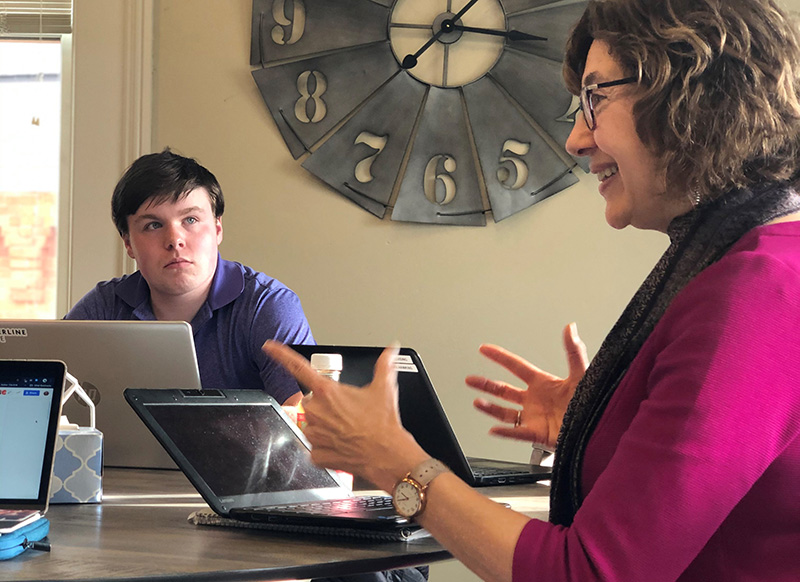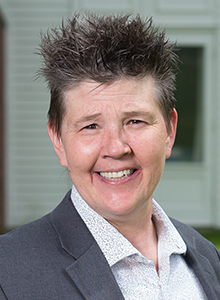Going to college after high school, particularly for neuroatypical learners, can be like trying to get from one mountain top to another without a bridge or tools of any kind. Lesson number one is just knowing that: Be prepared for a massive gap between one set of teaching, learning, and support structures and another. Thankfully, lesson two is a bit more optimistic: neuroatypical students can find the right tools, learn how to use them, and build their own bridges.

To help him achieve success in college, Chris receives individualized support from a CIP academic coordinator
For many students, lesson three is that success in college may have very little to do with the depth and breadth of academic knowledge that a student has accumulated up to that point. College success is about a student’s ability to adapt how they learn and remain motivated during that process. In a study published by the American Psychological Association, one student puts it quite succinctly: “In high school, you learn the material in class. In college, most learning takes place outside the classroom.” The standard college expectation is that for each college three-credit class a student takes, they need to spend at least 6 hours per week as an independent learner. When I taught in college, I also instructed my students that: “More important than how much someone should study is how someone should study. Studying is a skill.” Lesson four is that college professors do not actually teach that skill.
In high school, neuroatypical teens have a team supporting them in how to study, including teachers, parents, paraprofessionals, aides, counselors, and administrators. Lesson five might be the single most important factor in transitioning successfully from high school to college: in college, students have no such team. At programs such as The College Internship Program (CIP) which specialize in working with neuroatypical students, part of the support students receive is guidance in assembling their own team which will help them manage their time, learn new study skills, monitor their progress, and learn, if possible, which college faculty are most prepared to teach neurotypical students. Students need to connect and maintain the connection to key supportive resources on campus that will be crucial for academic success: tutors, the disability services office, academic advisors, the writing center, and math labs. Family members can often provide some of this guidance, but it is important to remember that—by federal law—the student must be the lead actor in any of these efforts.
Lesson six is that students must understand and adapt to the differences between high school and college teaching. Among other things, college professors do not generally provide regular reminders about when assignments are due, they do not follow a rubric according to which they tell students the most important points to learn, they do not review the previous day or week’s sessions, they frequently will not accept late assignments, they often neither take attendance nor report absences to anyone, and they often do not check homework. Importantly, while by law they must provide accommodations to the student, they cannot (also by law) make modifications to the curriculum.
Moreover, a student who had an IEP in secondary school received support and instructions by teachers and other professionals with extensive and specific training in how to teach to students with learning differences. Most instructors in college have little to no training in how to teach at all. Some professors—and I like to think I was one—obtained significant on-the-job training in graduate school and beyond, and many have learned how to teach quite well. However—and this is an extremely important point—college professors almost never receive training in how to teach neuroatypical students.
As Wil Del Pilar, vice president of higher education policy and practice at the Education Trust, puts it: “[Faculty] are not trained to meet the different learning outcomes or style of everyone, or the unique needs of students.” In short, a neuroatypical student who has been taught their entire life by highly trained professionals will enter an environment that is highly unstructured, appearing on day one in a class of hundreds of students with professors who have no experience in teaching students with learning differences.
Students’ primary (and often sole) points of contact will be individual professors who typically do not even know each other, much less collaborate to support individual students. Lesson seven is knowing that the responsibility for communicating with those faculty members—the core members of a students’ learning team—falls 100% on the student. Professors are prohibited by law to talk to parents about any student’s performance in their class. Self-advocacy and social skills are critical in gaining these team members’ support.
For example, while professors must, by law, provide accommodations, they are also prohibited by law from inquiring further about why a student needs them or how they help the student. So even if a professor has years of on-the-job training in teaching neuroatypical students, they will have no idea which learning difference their students actually have. Those professors might have innovative approaches that they are not sharing because they have no idea if they would be beneficial. Plus, while professors can seem intimidating—with “no exceptions” or “no extensions” plastered across the syllabus—solid self-advocacy skills can help students cut through those warnings and learn when, and how, to ask for exceptions, extensions, or any other additional support above and beyond that which is required by law. By contrast, the simple rule “if you don’t ask the answer is always no” applies here as well: if a student does not approach their professor in a timely manner for extra help, exceptions, or extensions, they will not be simply offered. Finally, in most cases, professors don’t communicate with advisors at all unless there is already a problem, and by then it is often too late to salvage a student’s grade.
Lesson eight provides a context for how college is taught today: the type of professor that students are most likely to meet is an adjunct faculty member. Nationwide, about 75% of all college and university faculty are adjuncts. This does not mean they are second-rate teachers, but they are second-tier employees. The conditions of being an adjunct faculty member impacts these professors’ ability to connect meaningfully with students outside of the classroom: adjuncts frequently do not have offices and since pay is extremely low, most adjuncts teach at multiple college campuses, often living far from the college campus and carrying extremely burdensome course loads. Sometimes they might need additional jobs just to make ends meet. I know this all too well as I spent over a decade as an adjunct at a list of colleges too long to summarize here.
It’s not that adjuncts want to be inaccessible, but it may feel that way to the students. It’s also difficult to find and build mentoring relationships with adjunct faculty. A neuroatypical student may find a great professor who really “gets” them and with whom they can connect easily. That student may even want to ask for a recommendation someday. But students cannot count on their professors being around the following semester, and without advanced planning, may have no way to contact those professors after the semester ends. These are just some of the reasons why students must be firm and clear in initiating and maintaining contact with their adjunct professors.
Lesson nine is that in order to navigate all of these factors and be successful in college, neuroatypical students need to develop an advocacy plan in advance. Key elements of the plan include building a team of supportive adults, getting to know the staff at the disabilities resource center and actively asking for their help in identifying resources beyond those which are required by law, regularly making use of the resources available, and working hard at getting to know instructors. While it is a highly personal and individual decision, students might also consider the benefits of disclosing their diagnosis to professors and academic advisors: this might provide them with helpful information about how to address specific learning needs beyond the accommodations required by law. Programs like CIP can be invaluable for students with learning differences who benefit from additional support with transitioning from high school to college.
Lesson ten takes us back to the beginning, standing at the mountain top called “finishing high school.” It might be helpful to work with young adults to assess their readiness for college by asking realistic, and sometimes quite difficult, questions about whether they want to proceed directly to college at all. This is something that we spend time on during the application process at CIP as well as in a student’s first semester. Taking a semester or even a year off between high school and college and finding ways to develop executive functioning, communication skills, and self-advocacy may make the difference between success and failure in college. And if the team is certain that college is the next step, start slowly and expect big changes ahead. Personally—having spent so many years teaching at the college level—I think it’s worth it. But students must also believe that with all their heart.
About the Author
Before joining The College Internship Program, Mary worked for twenty years in the field of post-secondary education as an instructor and administrator. She served as adjunct faculty at several colleges and universities in the northeast. As National Enrollment Specialist at CIP, Mary is responsible for initiating and developing relationships with neurodiverse students and their families. She guides families through the CIP admissions process, from their first inquiry to their potential enrollment at one of five national centers.
About College Internship Program
The College Internship Program is a comprehensive transition program for young adults on the Autism Spectrum and with Learning Differences. Our Mission is to inspire independence and expand the foundation on which young adults with Autism, ADHD, and other Learning Differences can build happy and productive lives. For information about CIP, contact our National Admissions Office at 877-566-9247 or email admissions@cipworldwide.org.
References
https://www.apa.org/ed/precollege/ptn/2014/08/college-freshmen
Autism and Learning Differences—An Active Learning Teaching Toolkit, p 143
https://www.theatlantic.com/business/archive/2014/04/the-adjunct-professor-crisis/361336/





